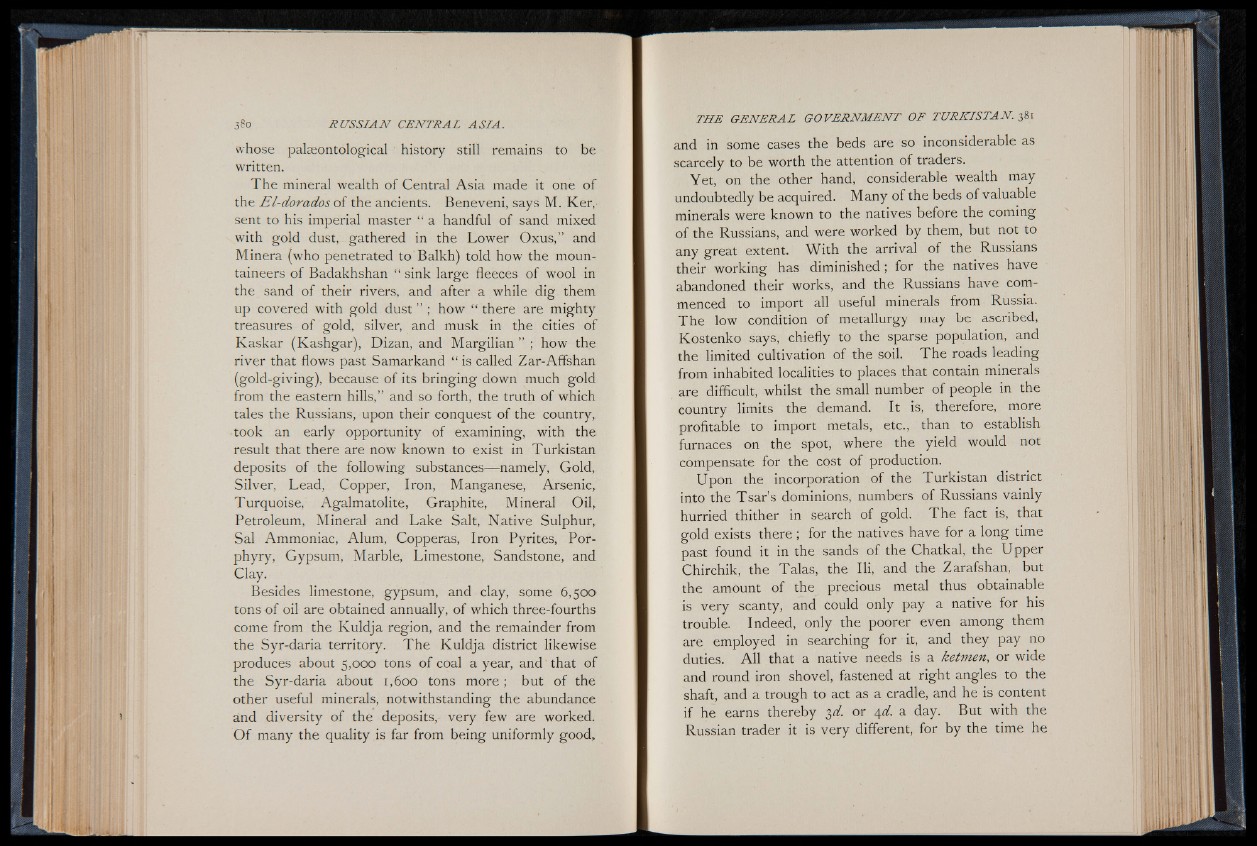
whose palaeontological history still remains to be
written.
The mineral wealth of Central Asia made it one of
the El-dorados o f the ancients. Beneveni, says M. Ker,
sent to his imperial master “ a handful of sand mixed
with gold dust, gathered in the Lower Oxus,” and
Minera (who penetrated to Balkh) told how the mountaineers
of Badakhshan “ sink large fleeces of wool in
the sand of their rivers, and after a while dig them
up covered with gold dust ” ; how “ there are mighty
treasures of gold, silver, and musk in the cities of
Kaskar (Kashgar), Dizan, and Margilian ” ; how the
river that flows past Samarkand “ is called Zar-Affshan
(gold-giving), because of its bringing down much gold
from the eastern hills,” and so forth, the truth of which
tales the Russians, upon their conquest of the country,
took an early opportunity of examining, with the
result that there are now known to exist in Turkistan
deposits of the following substances-— namely, Gold,
Silver, Lead, Copper, Iron, Manganese, Arsenic,
Turquoise, Agalmatolite, Graphite, Mineral Oil,
Petroleum, Mineral and Lake Salt, Native Sulphur,
Sal Ammoniac, Alum, Copperas, Iron Pyrites, Porphyry,
Gypsum, Marble, Limestone, Sandstone, and
Clay.
Besides limestone, gypsum, and clay, some 6,500
tons of oil are obtained annually, of which three-fourths
come from the Kuldja region, and the remainder from
the Syr-daria territory. The Kuldja district likewise
produces about 5,000 tons of coal a year, and that of
the Syr-daria about 1,600 tons more ; but of the
other useful minerals, notwithstanding the abundance
and diversity of the deposits, very few are worked.
O f many the quality is far from being uniformly good,
and in some cases the beds are so inconsiderable as
scarcely to be worth the attention of traders.
Yet, on the other hand, considerable wealth may
undoubtedly be acquired. Many of the beds of valuable
minerals were known to the natives before the coming
of the Russians, and were worked by them, but not to
any great extent. With the arrival of the Russians
their working has diminished ; for the natives have
abandoned their works, and the Russians have commenced
to import all useful minerals from Russia.
The low condition of metallurgy may be ascribed,
Kostenko says, chiefly to the sparse population, and
the limited cultivation of the soil. The roads leading
from inhabited localities to places that contain minerals
are difficult, whilst the small number of people in the
country limits the demand. It is, therefore, more
profitable to import metals, etc., than to establish
furnaces on the spot, where the yield would not
compensate for the cost of production.
Upon the incorporation of the Turkistan district
into the Tsar’s dominions, numbers of Russians vainly
hurried thither in search of gold. The fact is, that
gold exists there ; for the natives have for a long time
past found it in the sands of the Chatkal, the Upper
Chirchik, the Talas, the Ili, and the Zarafshan, but
the amount of the precious metal thus obtainable
is very scanty, and could only pay a native for his
trouble. Indeed, only the poorer even among them
are employed in searching for it, and they pay no
duties. All that a native needs is a ketmen, or wide
and round iron shovel, fastened at right angles to the
shaft, and a trough to act as a cradle, and he is content
if he earns thereby 3^. or 4d. a day. But with the
Russian trader it is very different, for by the time he